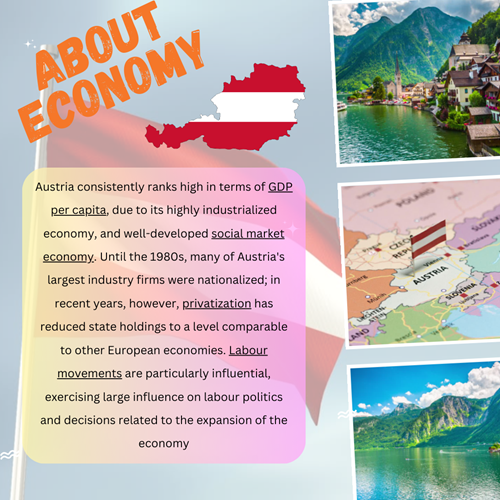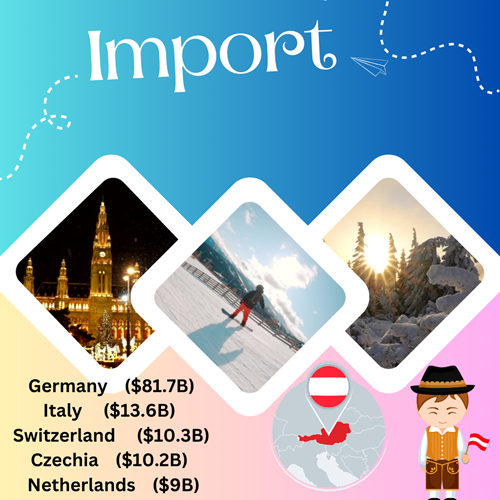Analysis and Studies - Country Analysis
Austria at a glance: economy overview
March 14th 2024

Austria, formally the Republic of Austria is a landlocked country in Central Europe, lying in the Eastern Alps. Austria borders Czechia, Germany, Hungary, Italy, Slovakia, Slovenia, and Switzerland by land. It is a federation of nine federal states, one of which is the capital, Vienna, the most populous city and federal states.
Moreover, Austria has been a member of the United Nations since 1995 and of the European Union since 1995. It hosts the OSCE (Organization for Security and Co-operation in Europe) and OPEC (Organization of the Petroleum Exporting Countries) and is a founding member of OECD and Interpol (The International Criminal Police Organization). It also signed the Schengen Agreement in 1995, and adopted the euro currency in 1999.

About Economy
Austria consistently ranks high in terms of GDP per capita, due to its highly industrialized economy, and well-developed social market economy. Until the 1980s, many of Austria's largest industry firms were nationalized; in recent years, however, privatization has reduced state holdings to a level comparable to other European economies. Labour movements are particularly influential, exercising large influence on labour politics and decisions related to the expansion of the economy. Next to a highly developed industry, international tourism is the most important part of the economy of Austria.
Germany has historically been the main trading partner of Austria, making it vulnerable to rapid changes in the German economy. Since Austria became a member state of the European Union, it has gained closer ties to other EU economies. Membership of the EU has drawn an influx of foreign investors attracted by Austria's access to the single European market and proximity to the aspiring economies of the European Union. Growth in GDP reached 3.3 percent in 2006. At least 67 percent of Austria's imports come from other European Union member states. In 2021, Austria was the number 29 economy in the world in terms of GDP (current US$), the number 31 in total exports, the number 28 in total imports, the number 21 economy in terms of GDP per capita (current US$) and the number 9 most complex economy according to the Economic Complexity Index (ECI).

EXPORTS
The top exports of Austria are Vaccines, blood, antisera, toxins and cultures ($7.24B), Cars ($7.2B), Packaged Medicaments ($6.76B), Motor vehicles; parts and accessories (8701 to 8705) ($4.92B), and Broadcasting Equipment ($3.96B), exporting mostly to Germany ($56.4B), Italy ($13.1B), United States ($12.7B), Switzerland ($10.1B), and Hungary ($7.99B).
In 2021, Austria was the world's biggest exporter of Flavored Water ($3.49B), Wood Carpentry ($1.97B), Iron Railway Products ($581M), Cigarette Paper ($480M), and Handguns ($451M)

IMPORTS
The top imports of Austria are Cars ($8.7B), Broadcasting Equipment ($5.65B), Vaccines, blood, antisera, toxins and cultures ($5.5B), Gold ($5.1B), and Motor vehicles; parts and accessories (8701 to 8705) ($5.01B), importing mostly from Germany ($81.7B), Italy ($13.6B), Switzerland ($10.3B), Czechia ($10.2B), and Netherlands ($9B).
In 2021, Austria was the world's biggest importer of Slag Dross ($103M)
Top Export (2021)Vaccines, blood, antisera, toxins and cultures $7.24B
Top Destination (2021): Germany $56.4B
Fonti:
https://oec.world/en
https://data.worldbank.org/
https://www.trademap.org/
